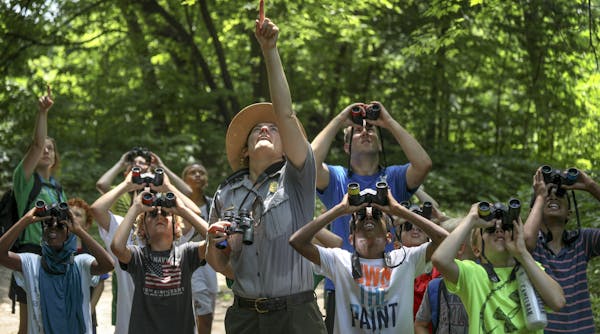Minnesotans are embracing the outdoors and visiting state parks with increasing frequency to hike, camp and bike — some of them for the first time.
Since 2003, the state's annual park visits have grown 25 percent, outpacing population growth. The biggest crowd came in 2016, when the parks logged 10.3 million visits. That was followed by a slight downturn in 2017, which Erika Rivers, state parks and trails director with the Minnesota Department of Natural Resources, attributed to a rainy summer.
The growth coincides with record-breaking interest in national parks and a shift from far-off vacations to more local camping trips.
In Minnesota, much of the growth can be attributed to 2008's Clean Water, Land and Legacy Amendment, Rivers said. The ⅜ percent tax has paid for $2 billion dollars in projects that include millions in state park improvements.
At Minneopa State Park near Mankato, the funds brought a herd of 20 bison to the prairie land park. Massive bulls, cows and caramel-colored calves now range on land they used to roam centuries ago. The return has attracted droves of curious onlookers peeking from their car windows — the park saw a 35 percent increase in attendance after the animals were added in 2015.
"Overall it's been a boost for us here," said Todd Dailey, assistant park manager at Minneopa.
The park that saw the biggest percentage increase in visits since 2003 was Cuyuna Country State Recreation Area, which added a network of mountain biking trails. And the state's most popular parks — attendance juggernauts mostly along the North Shore or near the Twin Cities — saw hundreds of thousands of visitors in 2017. Gooseberry Falls State Park was the most popular park with nearly 900,000 visits.
The Legacy Amendment also led to the I Can! Program Series that eases wary participants into camping, mountain biking and other activities.
"These are largely focused on people who have never been camping, paddling or fishing before," Rivers said, "or they haven't done it in many years and need a refresher."
Families like Megan Weed's are among those park officials hope to attract.
The family of four isn't particularly outdoorsy, Weed said, but they tried camping with another family this summer at Father Hennepin State Park. Their trip was full of bug bites, restless toddlers and all the challenges faced by first-time campers with kids. But they also hiked, swam and made s'mores around the campfire, experiences Weed said inspired them to venture out again.
"I think there is something that's really empowering [about camping]," she said. "You feel self-sufficient and self-reliant for that time."
'It's top notch'
The increase in attendance is also a testament to Minnesotans' pride in natural resources, Rivers said. In the midst of the recession, 56 percent of Minnesotans voted to raise their taxes to fund projects to protect land and keep water clean. The tax, which also funds arts and cultural heritage projects, began in July 2009 and will expire in 2034.
"I think that says a lot about the citizenry of Minnesota," Rivers said. "We value quality of life here so much that we are willing to make these investments."
The story hasn't been the same across the country, Rivers said. Many states saw cuts to budgets during the recession, and while Minnesota wasn't safe from that, the boost in capital funding allowed officials to pursue ambitious projects.
As a result, Minnesota ranks high in state park attendance nationally, said Rivers, who is a board member for the National Association of State Park Directors.
Dailey, who has worked at 15 different Minnesota state parks since 1998, has noticed the increase in visitors at Minneopa. Its campground that used to be at best two-thirds full is often at capacity, he said.
"There's just not another state in my mind that holds a candle to what Minnesota does and has to offer," Dailey said. "It's top notch. The people of Minnesota care about their parks."
Chris Bowling • 612-673-4434

Souhan: This is KAT's chance to prove Flip was right

